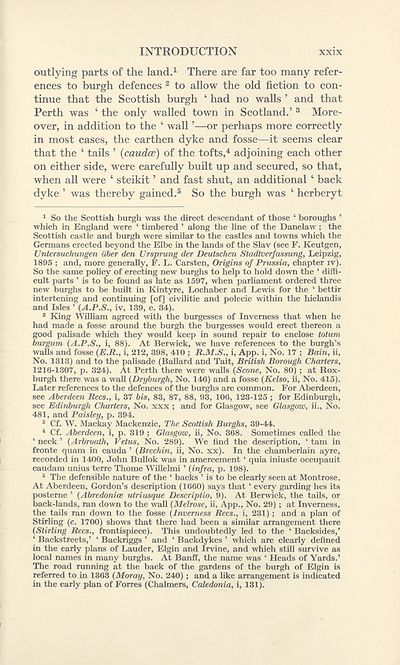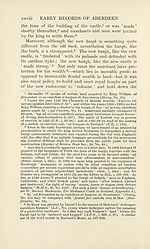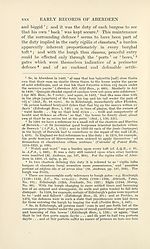Series 3 > Early records of the Burgh of Aberdeen
(34) Page xxix
Download files
Complete book:
Individual page:
Thumbnail gallery: Grid view | List view

INTRODUCTION
XXIX
outlying parts of the land.1 There are far too many refer¬
ences to burgh defences 2 to allow the old fiction to con¬
tinue that the Scottish burgh ‘ had no walls ’ and that
Perth was ‘ the only walled town in Scotland.’ 3 More¬
over, in addition to the ‘ wall ’—or perhaps more correctly
in most cases, the earthen dyke and fosse—it seems clear
that the ‘ tails ’ {caudce) of the tofts,4 adjoining each other
on either side, were carefully built up and secured, so that,
when all were 1 steikit ’ and fast shut, an additional ‘ back
dyke ’ was thereby gained.5 So the burgh was ‘ herberyt
1 So the Scottish burgh was the direct descendant of those ‘ boroughs ’
which in England were ‘ timbered ’ along the line of the Danelaw ; the
Scottish castle and burgh were similar to the castles and towns which the
Germans erected beyond the Elbe in the lands of the Slav (see F. Keutgen,
Untersuchungen uber den Ursprung der Deutschen Stadtverfassung, Leipzig,
1895 ; and, more generally, F. L. Carsten, Origins of Prussia, chapter iv).
So the same policy of erecting new burghs to help to hold down the ‘ diffi¬
cult parts ’ is to be found as late as 1597, when parliament ordered three
new burghs to be built in Kintyre, Lochaber and Lewis for the ‘ bettir
intertening and continuing [of] civilitie and polecie within the hielandis
and Isles ’ (A.P.S., iv, 139, c. 34).
2 King William agreed with the burgesses of Inverness that when he
had made a fosse around the burgh the burgesses would erect thereon a
good palisade which they would keep in sound repair to enclose totum
burgum (A.P.S., i, 88). At Berwick, we have references to the burgh’s
walls and fosse (E.R., i, 212, 398, 410 ; R.M.S., i, App. i, No. 17 ; Bain, ii,
No. 1313) and to the palisade (Ballard and Tait, British Borough Charters,
1216-1307, p. 324). At Perth there were walls (Scone, No. 80) ; at Rox¬
burgh there was a wall (Dryburgh, No. 146) and a fosse (Kelso, ii, No. 415).
Later references to the defences of the burghs are common. For Aberdeen,
see Aberdeen Rees., i, 37 bis, 83, 87, 88, 93, 106, 123-125 ; for Edinburgh,
see Edinburgh Charters, No. xxx; and for Glasgow, see Glasgow, ii., No.
481, and Paisley, p. 394.
3 Cf. W. Mackay Mackenzie, The Scottish Burghs, 39-44.
4 Cf. Aberdeen, i, p. 319 ; Glasgow, ii, No. 368. Sometimes called the
‘ neck ’ (Arbroath, Vetus, No. 289). We find the description, ‘ tarn in
fronte quam in cauda ’ (Brechin, ii. No. xx). In the chamberlain ayre,
recorded in 1400, John Bullok was in amercement ‘ quia iniuste occupauit
caudam unius terre Thome Willelmi ’ (infra, p. 198).
5 The defensible nature of the ‘ backs ’ is to be clearly seen at Montrose.
At Aberdeen, Gordon’s description (1660) says that ‘ every garding hes its
posterne ’ (Abredonice utriusque Descriptio, 9). At Berwick, the tails, or
back-lands, ran down to the wall (Melrose, ii, App., No. 29) ; at Inverness,
the tails ran down to the fosse (Inverness Rees., i, 231); and a plan of
Stirling (c. 1700) shows that there had been a similar arrangement there
(Stirling Rees., frontispiece). This undoubtedly led to the 4 Backsides,’
4 Backstreets,’ 4 Backriggs ’ and 4 Backdykes ’ which are clearly defined
in the early plans of Lauder, Elgin and Irvine, and which still survive as
local names in many burghs. At Banff, the name was 4 Heads of Yards.’
The road running at the back of the gardens of the burgh of Elgin is
referred to in 1363 (Moray, No. 240) ; and a like arrangement is indicated
in the early plan of Forres (Chalmers, Caledonia, i, 131).
XXIX
outlying parts of the land.1 There are far too many refer¬
ences to burgh defences 2 to allow the old fiction to con¬
tinue that the Scottish burgh ‘ had no walls ’ and that
Perth was ‘ the only walled town in Scotland.’ 3 More¬
over, in addition to the ‘ wall ’—or perhaps more correctly
in most cases, the earthen dyke and fosse—it seems clear
that the ‘ tails ’ {caudce) of the tofts,4 adjoining each other
on either side, were carefully built up and secured, so that,
when all were 1 steikit ’ and fast shut, an additional ‘ back
dyke ’ was thereby gained.5 So the burgh was ‘ herberyt
1 So the Scottish burgh was the direct descendant of those ‘ boroughs ’
which in England were ‘ timbered ’ along the line of the Danelaw ; the
Scottish castle and burgh were similar to the castles and towns which the
Germans erected beyond the Elbe in the lands of the Slav (see F. Keutgen,
Untersuchungen uber den Ursprung der Deutschen Stadtverfassung, Leipzig,
1895 ; and, more generally, F. L. Carsten, Origins of Prussia, chapter iv).
So the same policy of erecting new burghs to help to hold down the ‘ diffi¬
cult parts ’ is to be found as late as 1597, when parliament ordered three
new burghs to be built in Kintyre, Lochaber and Lewis for the ‘ bettir
intertening and continuing [of] civilitie and polecie within the hielandis
and Isles ’ (A.P.S., iv, 139, c. 34).
2 King William agreed with the burgesses of Inverness that when he
had made a fosse around the burgh the burgesses would erect thereon a
good palisade which they would keep in sound repair to enclose totum
burgum (A.P.S., i, 88). At Berwick, we have references to the burgh’s
walls and fosse (E.R., i, 212, 398, 410 ; R.M.S., i, App. i, No. 17 ; Bain, ii,
No. 1313) and to the palisade (Ballard and Tait, British Borough Charters,
1216-1307, p. 324). At Perth there were walls (Scone, No. 80) ; at Rox¬
burgh there was a wall (Dryburgh, No. 146) and a fosse (Kelso, ii, No. 415).
Later references to the defences of the burghs are common. For Aberdeen,
see Aberdeen Rees., i, 37 bis, 83, 87, 88, 93, 106, 123-125 ; for Edinburgh,
see Edinburgh Charters, No. xxx; and for Glasgow, see Glasgow, ii., No.
481, and Paisley, p. 394.
3 Cf. W. Mackay Mackenzie, The Scottish Burghs, 39-44.
4 Cf. Aberdeen, i, p. 319 ; Glasgow, ii, No. 368. Sometimes called the
‘ neck ’ (Arbroath, Vetus, No. 289). We find the description, ‘ tarn in
fronte quam in cauda ’ (Brechin, ii. No. xx). In the chamberlain ayre,
recorded in 1400, John Bullok was in amercement ‘ quia iniuste occupauit
caudam unius terre Thome Willelmi ’ (infra, p. 198).
5 The defensible nature of the ‘ backs ’ is to be clearly seen at Montrose.
At Aberdeen, Gordon’s description (1660) says that ‘ every garding hes its
posterne ’ (Abredonice utriusque Descriptio, 9). At Berwick, the tails, or
back-lands, ran down to the wall (Melrose, ii, App., No. 29) ; at Inverness,
the tails ran down to the fosse (Inverness Rees., i, 231); and a plan of
Stirling (c. 1700) shows that there had been a similar arrangement there
(Stirling Rees., frontispiece). This undoubtedly led to the 4 Backsides,’
4 Backstreets,’ 4 Backriggs ’ and 4 Backdykes ’ which are clearly defined
in the early plans of Lauder, Elgin and Irvine, and which still survive as
local names in many burghs. At Banff, the name was 4 Heads of Yards.’
The road running at the back of the gardens of the burgh of Elgin is
referred to in 1363 (Moray, No. 240) ; and a like arrangement is indicated
in the early plan of Forres (Chalmers, Caledonia, i, 131).
Set display mode to:
![]() Universal Viewer |
Universal Viewer | ![]() Mirador |
Large image | Transcription
Mirador |
Large image | Transcription
Images and transcriptions on this page, including medium image downloads, may be used under the Creative Commons Attribution 4.0 International Licence unless otherwise stated. ![]()
| Scottish History Society volumes > Series 3 > Early records of the Burgh of Aberdeen > (34) Page xxix |
|---|
| Permanent URL | https://digital.nls.uk/126829731 |
|---|
| Attribution and copyright: |
|
|---|
| Description | Over 180 volumes, published by the Scottish History Society, containing original sources on Scotland's history and people. With a wide range of subjects, the books collectively cover all periods from the 12th to 20th centuries, and reflect changing trends in Scottish history. Sources are accompanied by scholarly interpretation, references and bibliographies. Volumes are usually published annually, and more digitised volumes will be added as they become available. |
|---|


